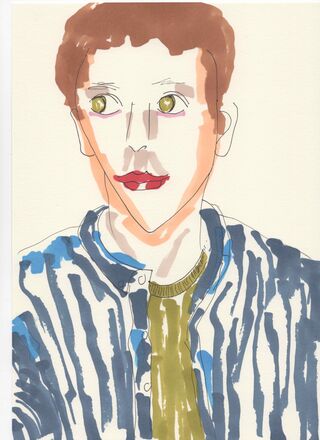
Ruth is timid, polite, and loves reading books. Esther is outgoing and loves to meet new people, but she can’t handle stress very well. Tom is rather lazy but creative and open to every adventure his friends suggest. Ruth, Esther, and Tom have different personalities. But how do they differ, and can this difference be systematized?
To answer this question, one has to stand back and ask: What actually is personality? In other words, if I met you, how could I get to know who you are? Which questions would I ask you, and which answers would I get? What would remain hidden?
There are various aspects that could describe you. For instance, you could tell me about your job, whether you have children, and which hopes you have. You could mention your three main life goals or let me know whether you would describe yourself as an assertive person.
To sort these manifold aspects, personality psychologists have established models and frameworks. One very prominent example is the integrative framework for studying people (McAdams, 2013; McAdams & Pals, 2006), according to which personality is built of three levels. These levels encompass the social actor, the motivated agent, and the autobiographical author. Attributes on these levels would describe Ruth, Esther, and Tom, as well as all other people, including you and me.
The social actor describes how people are on the “daily stage of life.” That is, the social actor describes how people think, feel, and behave in their everyday living, such as when they go to work, talk to their best friend, or have dinner. One of the most common taxonomies that personality psychologists use for the social actor is the Big Five personality traits (John & Srivastava, 1999): openness to experience, conscientiousness, extraversion, agreeableness, and neuroticism, summarized as OCEAN.
People high in openness tend to be intellectual, imaginative, and open-minded, while people high in conscientiousness are thorough, organized, responsible, dutiful, and self-regulated. People high in extraversion tend to be talkative, sociable, assertive, and active, are likely to seek out potentially rewarding situations, and are characterized by positive affect. People high in agreeableness tend to be gentle, good-natured, compliant, and cooperative, while people high in neuroticism tend to be anxious, moody, and easily upset, and they perceive the (social) environment negatively.
So, how would you describe Ruth, Esther, and Tom according to these traits—and how would you describe yourself? Importantly, these traits are tendencies, meaning that your current thoughts, feelings, and behaviors might be different from your general tendencies just because the situation demands more creativeness, assertiveness, or silence compared to your general tendency.
While the social actor is in the here and now—describing how people think, feel, and behave—the motivated agent projects into the future. That is, the motivated agent includes all aspects that speak to the motivations, goals, aims, expectations, and other social-cognitive characteristics that people have. For instance, Esther might be particularly outgoing because she aims to find a new partner, or Ruth can lose herself in books because she really wants to understand electromagnetic radiation. As such, goals provide people a reason to do what they do and to invest energy and time into their projects. The motivated agent also plays a crucial role in romantic relationships, as we have seen in the blog post on the Michelangelo phenomenon, describing how partners can be allies in each other’s personal growth and goal process.
Finally, the autobiographical author connects the here and now with the future and the personal past. To do so, the autobiographical author narrates individual life stories with high points, low points, and turning points. For instance, Tom might have been shy in his teenage years, but moving to another country was a turning point for him and resulted in him being much more adventurous now. Thus, a life story provides guidance, structure, and, most importantly, a life story provides identity.
As William Dunlop (2015), a narrative personality psychologist, described, a life narrative is the most individual aspect of a person because even if two people had the exact same experiences, they would never tell the exact same story. Also, narratives are never static. Our lives are constantly unfolding, and so are people’s narratives constantly in flux.
We all are the social actor, the motivated agent, and the autobiographical author in every single moment. We think, feel, and behave in certain ways, are motivated by our goals, and can tell how we have become the person we are. Hence, the levels are not separate parts of the person, but they are theoretically and empirically related to each other (Bühler et al., 2020). Together, they reflect who we are as a person.
As we will further discuss in this blog, each personality characteristic on each level—be it traits, goals, or narratives—is interrelated with romantic relationships. This is what makes the interplay between personality and romantic relationships so fascinating. Given the diversity of personality, there is still much to be explored here.
References
Bühler, J. L., Weidmann, R., & Grob, A. (2020). The actor, agent, and author across the life span: Interrelations between personality traits, life goals, and life narratives in an age-heterogeneous sample. European Journal of Personality. Advance online publication. https://doi.org/10.1002/per.2275
Dunlop, W. L. (2015). Contextualized personality, beyond traits. European Journal of Personality, 29, 310–325. https://doi.org/10.1002/per.1995
John, O. P., & Srivastava, S. (1999). The Big Five trait taxonomy: History, measurement, and theoretical perspectives. In L. A. Pervin, & O. P. John (Eds.), Handbook of personality: Theory and research (pp. 102–138). New York, NY: Guilford Press.
McAdams, D. P. (2013). The psychological self as actor, agent, and author. Perspectives on Psychological Science, 8, 272–295. https://doi.org/10.1177/1745691612464657
McAdams, D. P., & Pals, J. L. (2006). A new Big Five: Fundamental principles for an integrative science of personality. American Psychologist, 61, 204–217. https://doi.org/10.1037/0003-066x.61.3.204




